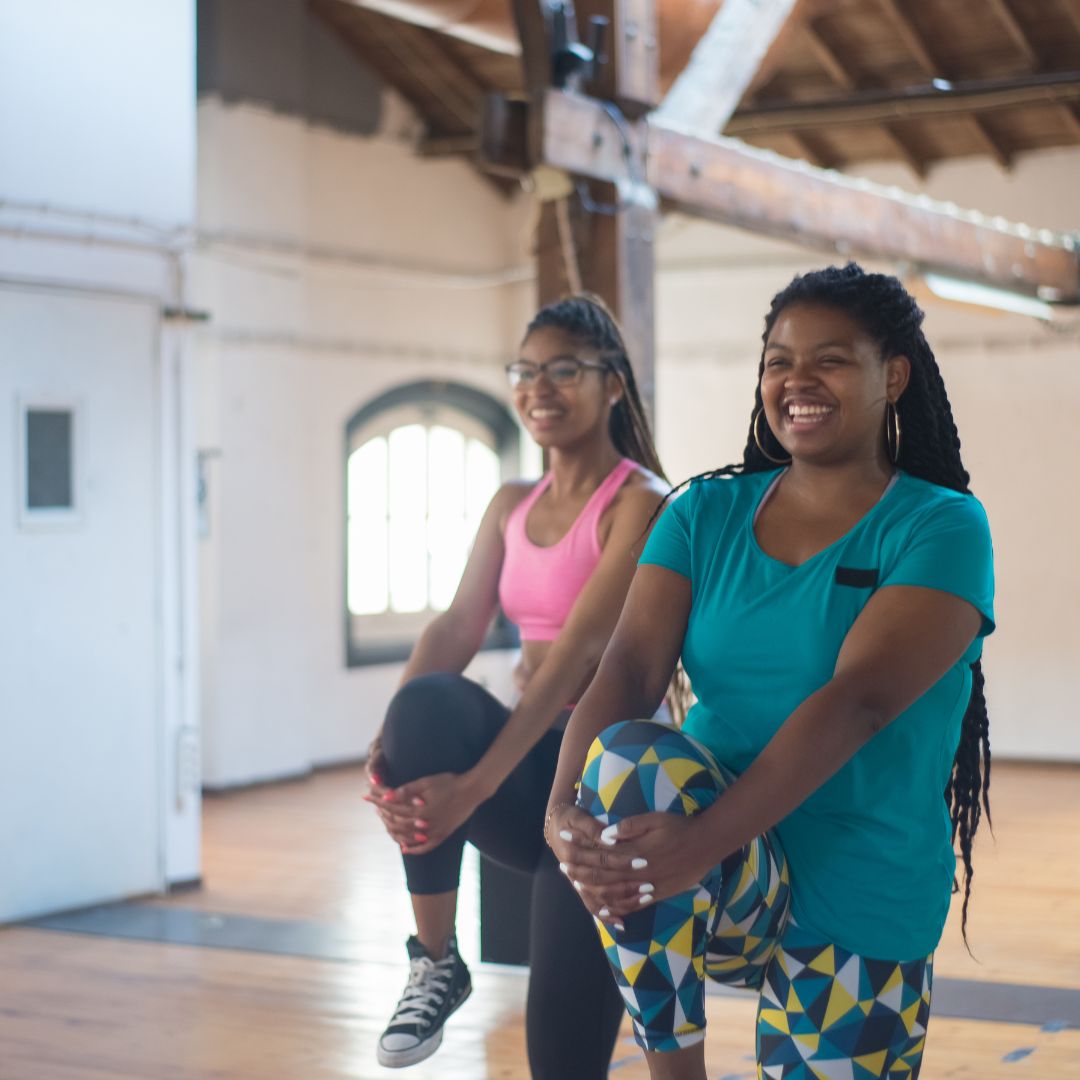
The Power of Small Changes
Many people begin January believing they need major changes to manage PCOS. It is easy to feel pressure to overhaul your whole lifestyle or follow restrictive plans that feel unsustainable. But the truth is that small, consistent actions often make the biggest difference. These gradual steps are easier to maintain and can support more stable energy, steadier appetite and an overall sense of greater control.
The following case studies help to show how simple changes helped three women begin to feel more balanced and confident in their routines. Each story reflects something I see often in practice: real progress begins with changes that fit the individual, rather than trying to force a perfect plan.
Why small changes make the biggest difference
PCOS can feel overwhelming because it touches so many areas of our life. When everything feels so intertwined, it is tempting to think you need a complete and utter reset. Yet research consistently shows that sustainable, moderate lifestyle adjustments can be more impactful than extreme diets or intense exercise plans.
Small changes work because:
These changes accumulate over time, creating momentum that feels manageable rather than stressful. For many women, this gentle approach makes PCOS feel far less intimidating.
Case study 1: Balancing blood sugar
Amira started the year feeling tired most mornings and often found herself searching for snacks by mid-afternoon. She had tried cutting out entire food groups in the past, but nothing seemed to stick. Instead of another strict plan, she chose one simple goal. She added protein to her breakfast each day.
She began making a balanced morning meal with oats, seeds, berries and a good source of protein. After a few weeks, she noticed she felt fuller for longer and more stable through the morning. Her energy was more consistent, and she felt more confident approaching the rest of her meals with the same balanced mindset.
A single daily habit had a ripple effect on her routine, making eating feel calmer and more predictable.
Case study 2: Adding movement gradually
Claire wanted to exercise more but felt overwhelmed by the idea of committing to long workouts. In the past, she would start an ambitious routine, stick with it for a week or two, then stop when life became busy or she didn’t have the energy to continue such a massive plan.
This time she focused on one achievable goal. She added a 10-minute walk after lunch on weekdays. It felt manageable and didn’t require any special planning. As her confidence grew, she extended a couple of walks and added gentle strength work twice a week.
Within a month, movement felt less like a chore and more like a positive part of her day. The steady routine supported her mood, energy and sense of wellbeing without the pressure of a strict programme.
Case study 3: Supporting gut health
Sofia had always struggled with digestive discomfort, which often left her feeling bloated and unsure about which foods worked best for her. Instead of cutting out several foods at once, she explored adding more fibre in a gentle, consistent way.
She began by including a portion of vegetables with lunch and dinner, then added ground flaxseed to her breakfast a few mornings a week. After a few weeks her digestion felt more regular, mealtimes felt easier and she had a clearer sense of what supported her body.
Supporting gut health did not require a major overhaul. Small additions created meaningful progress.
What you can take from these stories
Each of these women started with just one change. None of them relied on strict rules or dramatic plans. They each chose something realistic, repeatable and supportive of their goals.
You might begin by:
The most effective approach is the one that feels manageable for you. Progress with PCOS rarely comes from perfection. It comes from steady steps that you can keep returning to, even during busy or stressful times.
If you feel unsure about where to begin, you are not alone. A personalised plan that fits your lifestyle can make the process feel far more achievable and grounding. You don’t need drastic changes, just the right ones. Book a free call with us to see how you could start your own PCOS progress story.

Why movement matters in PCOS
Many of my clients with PCOS describe the same pattern: constant cravings, afternoon energy dips, and a sense that workouts don’t really make much of a difference. These can be common experiences when insulin resistance is part of the picture.
However, regular physical activity is one of the most effective ways to improve insulin sensitivity, support glucose control, and enhance overall metabolic health in PCOS. Exercise also benefits mood, sleep quality, and body confidence - all key areas that can be affected by PCOS.
The 2023 International Evidence-Based PCOS Guideline identifies movement as a first-line approach to managing PCOS symptoms and improving long-term health. UK guidance recommends at least 150 minutes of moderate activity per week (such as brisk walking or cycling) or 75 minutes of vigorous activity, along with strength training on two or more days each week. Breaking up long periods of sitting is equally important.
Strength training and insulin sensitivity
Resistance or strength training plays a central role in improving insulin sensitivity. It increases muscle mass, and muscle tissue is one of the main sites where glucose is stored and used for energy. The more efficiently muscles take up glucose, the less insulin the body needs to produce, reducing insulin resistance over time.
Several studies have shown that women with PCOS who include resistance training experience improvements in insulin sensitivity, body composition, and metabolic markers. This type of exercise also helps protect bone density and maintain healthy weight as we age.
If you’re new to it, begin with two sessions per week using your bodyweight, resistance bands, or light dumbbells. Focus on controlled movements that target major muscle groups - such as squats, lunges, presses, and rows. Over time, gradually increase the challenge by adding repetitions, sets, or resistance. But do check with your GP if you are new to exercise or have any other health conditions.
Cardio and blood sugar balance
Aerobic or cardiovascular exercise helps the body use glucose more efficiently during and after activity. For women with PCOS, both moderate-intensity and interval-based cardio have been shown to improve insulin resistance and cardiovascular fitness.
Moderate-intensity options include brisk walking, swimming, or cycling at a pace where you can still hold a conversation. If you enjoy shorter, more dynamic workouts, interval training, alternating periods of higher effort with active recovery can be highly effective for improving insulin sensitivity and energy levels.
Aim for activities you genuinely enjoy and can maintain consistently. The goal is regular movement, not perfection.
The role of daily activity (walking, stretching)
Exercise isn’t only about structured workouts. Small amounts of daily movement make a real difference to blood sugar control and energy levels.
Simple habits, like walking after meals, taking the stairs, standing during phone calls, or doing gentle stretches before bed, all help counter the effects of prolonged sitting.
Even 10 minutes of light activity after eating can support post-meal blood glucose regulation and help stabilise afternoon energy. Over time, these micro-movements build a foundation of consistent activity that supports metabolic and hormonal balance.
How to find the right exercise for you
The most effective movement plan is one that fits your current energy, preferences, and lifestyle. Consistency matters more than intensity.
A balanced weekly routine might include:
If you’re feeling tired, recovering from illness, or just getting started, gentle movement such as stretching, walking, or yoga is still beneficial. Gradually build up frequency and intensity as your energy and confidence grow.
For best results, pair regular movement with balanced nutrition, good sleep, and effective stress management - all of which further support insulin sensitivity and hormone balance.
For further information, check out our blog How to Fuel Exercise with PCOS or why not book a call?
This article is for educational purposes only and does not replace medical advice or diagnosis.

Are you saying I’m cranky?
Tackling Mood and PCOS
For many women with PCOS, irregular or absent periods are more than just a medical symptom. They can bring uncertainty, frustration, and even a sense of disconnection from your body. Some women I’ve worked with have described feeling “broken” or anxious about not knowing when their period will arrive, while others feel dismissed when their concerns are minimised by healthcare providers.
These emotional experiences are valid. Understanding the impact of irregular cycles is an important step in caring for both your physical and mental health.
Why irregular cycles affect emotions
Menstrual cycles are guided by a rhythm of hormonal changes that influence not only reproduction but also mood, energy, and mental wellbeing. In PCOS, irregular or absent ovulation means these hormones often do not follow their usual patterns. Instead of a predictable rise and fall of oestrogen and progesterone, women may experience fluctuating oestrogen with little or no progesterone to balance it.
This disruption can lead to:
Rather than being “all in your head,” these experiences are rooted in the biology of PCOS, which helps explain why mood changes are so common.
Research has shown that women with PCOS are significantly more likely to experience mood difficulties. One large UK survey reported that around 50% of women with PCOS met criteria for anxiety and nearly 14% experienced depression using standard screening tools. Other international studies have found that more than half of women with PCOS report depressive symptoms, with around a quarter experiencing anxiety symptoms. These rates are substantially higher than in women without PCOS, highlighting the very real emotional burden of the condition.
How hormonal changes influence mood
Alongside the unpredictability of cycles, hormonal imbalances themselves can affect emotional wellbeing.
These hormonal dynamics help explain why women with PCOS may experience more frequent or intense mood changes, beyond the emotional impact of irregular cycles alone.
PMS and PCOS
Premenstrual syndrome (PMS) describes the physical and emotional symptoms that occur in the days before a period. These may include mood swings, irritability, bloating, and breast tenderness. In PCOS, PMS can sometimes feel more severe.
Because cycles are often longer and ovulation less frequent, progesterone levels can remain low while oestrogen fluctuates. This imbalance contributes to symptoms such as heightened irritability, anxiety, and sleep disturbance. The unpredictability of cycles can also mean PMS arrives unexpectedly, adding to distress.
While PMS is very common, if symptoms are severe or interfere with daily life, it is important to discuss them with a healthcare professional.
When PMS becomes PMDD
For some women, premenstrual symptoms go beyond PMS and develop into premenstrual dysphoric disorder (PMDD), a recognised mood disorder. PMDD causes severe emotional symptoms such as intense mood swings, depression, irritability, or anxiety in the luteal phase of the cycle (the two weeks before menstruation).
Although research into PMDD in PCOS is still developing, the hormonal irregularities of PCOS may increase vulnerability in some women. If you suspect PMDD, it is important to speak to your GP. Diagnosis usually involves symptom charting across several cycles, and treatment options can include medical, psychological, and lifestyle approaches.
You do not need to suffer in silence. Support is available, and seeking help is an important step towards improving quality of life.
The impact of feeling dismissed
A common theme for many women with PCOS is feeling unheard when they raise concerns. Being told “it’s just irregular periods” or “come back when you’re trying for a baby” can feel incredibly invalidating. Over time, this can add to feelings of isolation and frustration.
Recognising that these concerns are legitimate – and that your emotional wellbeing matters as much as your physical symptoms – is an important part of managing PCOS.
Supportive ways to cope with cycle unpredictability
While irregular cycles cannot always be fully controlled, there are ways to feel more grounded and supported:
These strategies cannot change the underlying hormonal patterns alone, but they can restore a sense of control and self-compassion.
When to seek professional input
If irregular cycles, PMS, or possible PMDD are causing distress or interfering with daily life, it may help to seek support. A GP can investigate medical options, while a nutrition practitioner can help you explore evidence-based ways to support hormone balance.
It is important to remember that you deserve support not just for your physical health, but also for the emotional impact of living with PCOS. If you’d like to chat further, why not book a free call?

How to fuel exercise with PCOS
When you enter into a good, consistent exercise routine with PCOS, it can be incredibly effective in helping to manage symptoms (see blog). But it can be difficult to know how to fuel these workouts, particularly when following a lower carbohydrate diet and working to balance blood sugar.
Here are some top tips to follow to get the most from your workouts:
Don’t exercise when fasting
Probably the most important factor is not to exercise in a fasted state. While this can be beneficial for men, research shows that it is less helpful for female athletes. As stress can be a factor in driving symptoms of PCOS (see blog), exercising in a fasting state puts women’s bodies under undue pressure and therefore may increase PCOS symptoms. Women’s bodies respond better to exercise when fed than fasted, plus it helps with recovery. Therefore, adjust your workout to align with your eating schedules.
Ensure adequate protein intake
As a woman with PCOS, working on appropriate protein levels is key for blood sugar balance. But it’s also important for ensuring we get the most from our exercise plan. Prioritise protein, particularly after workouts, to ensure proper recovery and muscle repair. Aim for 15g of good quality protein before a workout and follow with 30-45g of protein with 3g of leucine after exercise for the best results.
Don’t exclude carbohydrates all together
Remember that we should focus on a low refined carbohydrate diet with PCOS, not a no carb diet. Aim to include some whole food, un-refined carbohydrates in your diet, such as legumes, starchy veg and low sugar fruits, like berries.
Listen to your body
Listen to how you feel, look at how you’re recovering from exercise, and how well you’re performing. You know your body better than anyone else, so learn to trust your instincts and fuel your body in the right way for you. Don’t forget the important of rest days, not overdoing it, and getting plenty of sleep to help ensure you continue to improve and feel good.
Exercise is essential for managing PCOS well – it helps with blood sugar balance, it helps with controlling inflammation, and it provides excellent mental health benefits. By fuelling your body well, you can continue to enjoy those benefits!
Disclaimer: The information provided by the health and wellness coach is not intended to be a substitute for professional medical advice, diagnosis, or treatment. You should always consult your doctor or other healthcare provider before changing your diet or starting an exercise programme.

How exercise can improve PCOS
Many of us with PCOS are told to ‘eat less and move more’ as a kind of panacea for our symptoms. It is not usually that helpful, as it is far too simplistic in dealing with a complex endocrine condition like PCOS. However, certain types of exercise can be helpful in managing symptoms and keeping PCOS under control. Let’s take a look at why.
High levels of insulin, or hyperinsulinaemia, leading to insulin resistance is one of the main driving factors behind PCOS symptoms. For more information on this, check out this blog. The improvement in insulin sensitivity that we gain from exercise is the main reason it can help with PCOS. Exercise improves insulin sensitivity by increasing the efficiency of how muscles respond to insulin, allowing them to take up more glucose from the bloodstream. Secondarily to that, exercise has also been seen to reduce oxidative stress and inflammation, both further drivers of PCOS (see this blog).
Research has shown us that women with PCOS who exercise regularly see improved menstrual regularity and improved ovulation. There are also further benefits in improved muscle tone, improved energy levels, and, possibly most importantly, improved mental health, particularly low mood and anxiety. So, what can we do to include exercise in our lives? And what types of exercise are best for those with PCOS?
If you’ve not exercised for a while, or if it’s not really ever been on your agenda, starting movement can be a daunting task. Adding in just one exercise session per week and doing it consistently is much more beneficial than trying to exercise every day and only managing it for a week. Start slowly, build the habit, and then layer on more types of movement. Gradually, over time, work up to the recommended 150 mins per week – or 30 minutes of exercise 5 days per week.
Additionally, if this is new to you, try out a variety of different activities. You might love the sounds of nature whizzing around on your bike in the countryside, or you may prefer pounding techno in a spin studio. The main thing is to find out what floats your boat.
Here are some simple ideas of how to incorporate movement easily into your day:
Incorporating stretching exercises into your daily routine can help improve flexibility and reduce muscle stiffness caused by prolonged sitting. Check out examples on YouTube or Google a local class.
Taking short breaks to stand up and walk around can help increase blood flow and reduce the negative effects of prolonged sitting on the body. Walking for 10 minutes after eating can also help to improve insulin sensitivity – win-win! Set an alarm on your phone to remind you to get up and move around, or if you have a smart watch enable the notification.
Incorporating strength training exercises, such as bodyweight exercises or light resistance training, is especially good for women with PCOS. Increased muscle mass helps to improve insulin sensitivity. Plus, the added androgens that we have from having PCOS can actually be of benefit here – we’re usually pretty good at weight training! Here it might be worth investing in some expertise – online programmes such as with Caroline Girvan or Joe Wicks are available or see if there are local classes or PTs you can work with.
Practicing yoga or Pilates can help improve posture, strengthen core muscles, and increase flexibility, all of which can help counteract the negative effects of sitting for long periods. There are heaps of online programmes, Yoga with Adriene being one of my faves. Or look online for local teachers and classes.
Incorporating cardiovascular exercise, such as walking, running, cycling, or swimming, into your routine can help improve circulation, increase energy levels, and reduce the risk of chronic diseases associated with prolonged sitting. What did you love as a child? Were you always out on your bike, or a familiar figure at the local pool. Tap into that. It’ll feel hard at first, but you’ll get into the swing of it.
Start small but be consistent. And before you know it, exercise will be part of your life!
What is the worst exercise for PCOS?
From initial research, there's no one 'worst' form of exercise, but studies have found that over-exercising and over-training can make periods irregular due to a spike in cortisol levels which can put your hormones into disarray.
The reason why a crazy sweat session (running, swimming, rowing, etc.) is typically not recommended for PCOS is because it can put your body under too much stress. This happens when you don’t give your body enough time to recover or if you’re exercising at a moderate pace for more than 60 minutes, causing your body to produce additional cortisol, a stress hormone.
Part of PCOS symptom management is stress reduction, so putting your body under additional stress can worsen your condition. I know how contradicting this all sounds, but below are the main points to remember if you are someone who loves heart pounding workouts and wants to continue those forms of exercises:
And if you'd like to chat further about movement and PCOS, why not get in touch?
Disclaimer: The information provided by the health and wellness coach is not intended to be a substitute for professional medical advice, diagnosis, or treatment. You should always consult your doctor or other healthcare provider before changing your diet or starting an exercise programme.

Your daily habits could be wrecking your mental health.
Here’s how to fix them
The way you start and structure your day plays a huge role in your mental wellbeing. Small, seemingly harmless habits - like checking your phone first thing or skipping breakfast - can set off a chain reaction that affects your mood, energy, and stress levels.
Circadian rhythm disruption can worsen PCOS symptoms due to its role in hormone regulation and overall metabolic health. Specifically, disruptions in circadian rhythms can affect hormones like cortisol, melatonin, and those related to reproduction (LH and testosterone), which are already often elevated in PCOS. Maintaining a regular sleep-wake cycle and healthy circadian rhythm can help manage PCOS symptoms by improving hormone balance and potentially reducing insulin resistance.
The good news is that you don’t need to overhaul your entire life to see improvements. Simple, strategic tweaks can have a big impact, helping you feel calmer, more in control, and more resilient to daily stress.
The stress loop - how modern life is making you more anxious
For many people, stress feels like a normal part of life. But modern habits are keeping stress levels high, even when there’s no immediate reason to feel anxious.
Cortisol, the body’s main stress hormone, follows a daily rhythm, naturally rising in the morning and tapering off at night. But common lifestyle choices - poor sleep, irregular eating, excessive screen time - disrupt this rhythm, leading to chronic stress and low resilience.
Erratic blood sugar levels can also play a role. When meals are skipped or loaded with refined carbs, blood sugar spikes and crashes, triggering cortisol release and creating a cycle of energy dips, cravings, and mood swings.
Breaking free from this loop means taking a closer look at your own daily habits and making small but powerful adjustments.
How your morning routine could be ruining your mood
Morning habits set the tone for the entire day. Some of the most common ones can actually increase stress levels, making it harder to stay focused, productive, and emotionally balanced.
Phone before food - scrolling through emails or social media first thing in the morning spikes cortisol, putting the body into stress mode before the day has even begun.
Caffeine on an empty stomach - coffee first thing might feel like a quick energy boost, but without food, it can cause a blood sugar crash later in the morning, affecting mood and focus.
Skipping protein at breakfast - protein provides the building blocks for neurotransmitters like dopamine and serotonin. A low-protein breakfast (or skipping breakfast entirely) can leave you feeling sluggish and irritable.
Lack of daylight exposure - natural light helps regulate the body’s internal clock and supports serotonin production, essential for mood and sleep. Spending the first hours of the day indoors can throw off this natural balance.
Making simple changes to the morning routine can help stabilise energy, improve focus, and set the stage for a calmer, more productive day.
5 daily habits that will boost your brain and lift your mood
Get light before screens - exposure to natural light in the morning helps regulate cortisol and serotonin levels. Stepping outside for five to ten minutes shortly after waking can improve mood, energy, and sleep quality. If you have time for a walk, that’s great. Even sitting outside with your morning cuppa will work.
Eat within an hour of waking - a balanced breakfast with protein, healthy fats, and fibre helps keep blood sugar steady, reducing mid-morning energy crashes and irritability. The stress hormone cortisol is naturally higher in the morning. Extending a fast until later in the morning – particularly if you’re already stressed – will cancel any positive gains you think you’re getting.
Move more, but gently - exercise is beneficial for mental health, but intense workouts can raise cortisol levels if the body is already under stress. Low-impact movement, like walking or stretching, can be a better choice for stress resilience.
Prioritise protein and healthy fats - protein-rich foods help produce two of the important brain chemicals that support mental wellbeing, dopamine and serotonin, while healthy fats support brain health and inflammation control. Good choices include eggs, nuts, seeds, oily fish, and avocado.
Set a wind-down boundary - evening habits influence how well the body handles stress the next day. Limiting screen time, dimming lights in the evening, and avoiding late-night work can support better sleep and stress regulation.
Small changes, big impact
Improving mental wellbeing doesn’t require a complete lifestyle overhaul. Focusing on small, sustainable habit shifts, such as getting more natural light, stabilising blood sugar, and setting healthy boundaries with screens, can make a noticeable difference in how you feel.
Trying just one of these habits for a week can be enough to see positive changes. The key is consistency over perfection. Making small but intentional choices each day can help break the stress cycle, improve resilience, and support long-term mental wellbeing.
So where will you start? What jumps out at you. And if you would like to talk more, don't hesitate to book in a free call with me here.